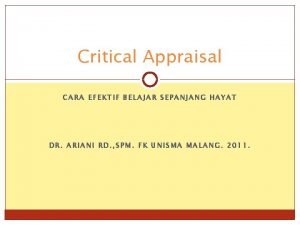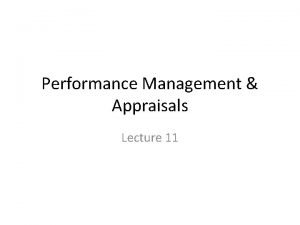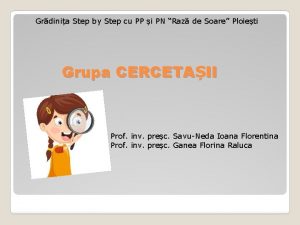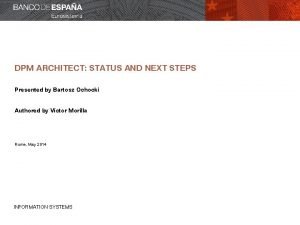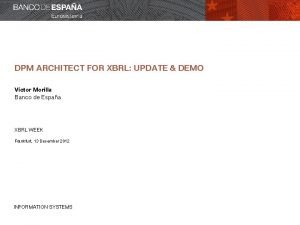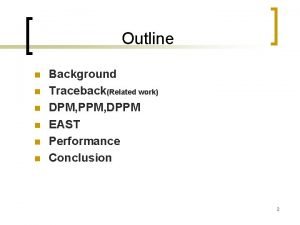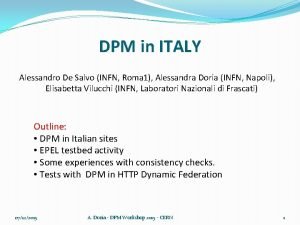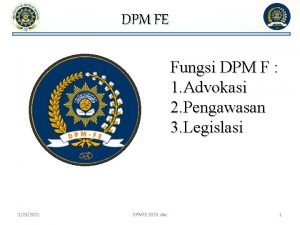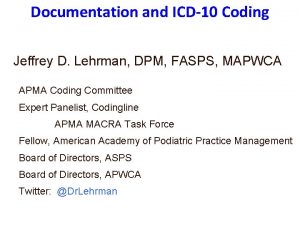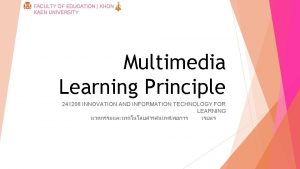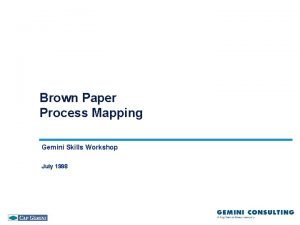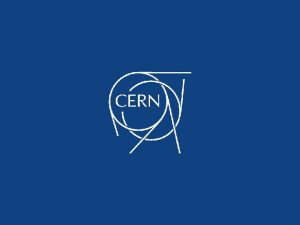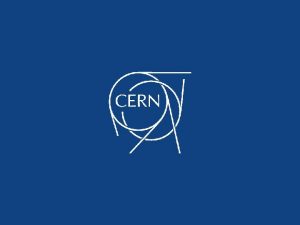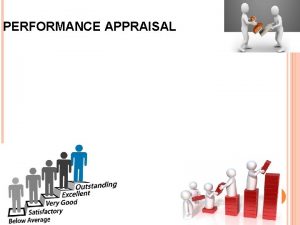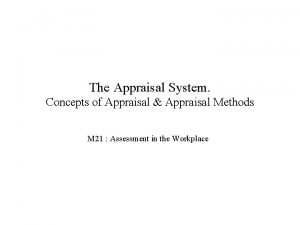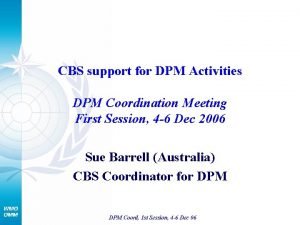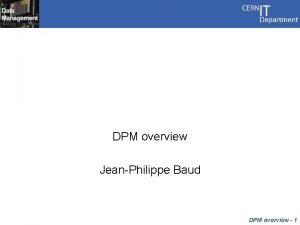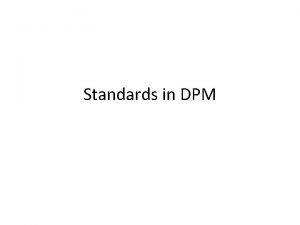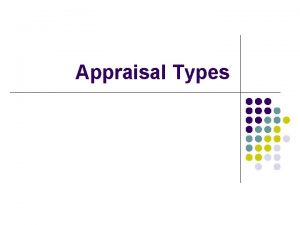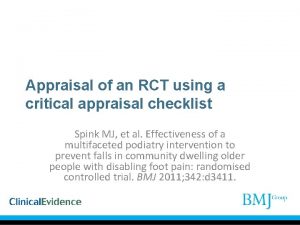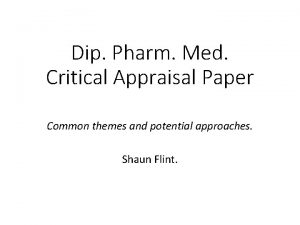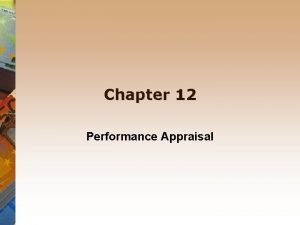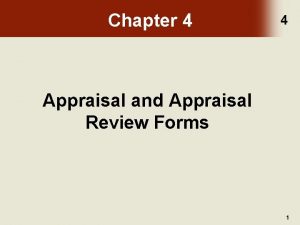Faculty Education Day DPM Critical Appraisal Paper Workshop












































- Slides: 44

Faculty Education Day DPM Critical Appraisal Paper Workshop Speakers: Examiners: Ruth Dixon, Gillian Pover, Juliet Roberts, Andy Webb DPM Candidate: Seema Parikh 16 June 2015

Workshop session contents • Introduction • Examiner’s Examples • Experiences of a Candidate • Examiner’s Concluding Remarks

Faculty Education Day Introduction

CAP Introduction • Tests ability to read and critique a paper • Fundamental requirement whatever discipline in pharmaceutical medicine you work in • ~ 13 questions (40% factual, 60% critique) • No requirement for all questions to be answered – but lose marks if you don’t! • time allowed 2½ hours • question paper and article given at same time • Answer in bullet form style please! (no essays)

CAP Introduction • Pass or Fail since 2013 (no E, G, P, BF, F) • Since conversion to a written exam the pass mark is typically around 57% (mean in the last few years 56. 36%, range 54 -59%)



CAP • Be careful what is asking for a factual answer e. g. List or State vs. • What is asking for your critique / opinion e. g. Give reasons for, Explain or Comment on …… • Think …. . “why is this important”…. the “so what!”

Example: Exclusion criterion = presence of a red traffic light Question: “Comment on the appropriateness of the patient population (do not simply repeat the inclusion / exclusion criteria)”

Example: • Poor answer = Red traffic light Not d e r e w ans Qu So t! a h w • Partial answer = Red traffic light so can’t cross the road • Good answer = Red traffic light, so can’t cross the road because it may be unsafe as high risk of getting run over! Now think about how to answer for a GFR or U&Es value!

Faculty Education Day Examiner’s Examples

1. Design Characteristics List “X” key design characteristics of the study • We are looking for terms such as: • Multicentre, double-blind, parallel group, Phase III, out-patient, superiority, 6 weeks treatment etc • We are not looking for details of: • patient selection, study conduct, method of data collection, statistical analysis etc

2. Patient Selection Patient selection • Question may be: o Give X general categories of reasons why patients were ineligible for the study or o Briefly explain why each of the following types of patients were not included in the study • Do not list the Exclusion Criteria

2. Patient Selection Answers: • Exclusion of patients taking specified concomitant medications o May confound interpretation of data e. g. due to dose changes o May interfere with safe use of study drug e. g. drug interactions Remember the “so what” red traffic light

2. Patient Selection Example 2014 paper In a study in mild to moderate hypertension why were patients with secondary hypertension excluded? Answers: • The antihypertensive medications tested may not work so effectively in hypertension secondary to other diseases and hence may confound / obscure any treatment effect or • Underlying disease should be treated which would improve the hypertension and so would confound the results

3. Lay terms explanations Describe the results “in lay terms” • Answers should: o Use language that a member of the public would understand i. e. no medical, scientific or statistical terms • Examples: o Explain diastolic blood pressure as the lowest value when the heart is relaxed between beats o Don’t refer to p values of less than 0. 001 …. . explain it as a 1 in 1000 chance

4. CONSORT diagram • Relatively high value question, 5 or 6 marks • Straightforward to answer, simply looking in the paper for the information o Provided you know what a consort diagram is and what disposition is! • Followed up by a critique of the gaps in the disposition data • Together = potential for a good number of marks

4. CONSORT diagram • This is about understanding the flow of participants through the study http: //www. consort-statement. org/consortstatement/checklist#/checklists/view/32 -consort/99 -participantflow? &_suid=1430470941092044540096188233163

4. CONSORT…. . looking for No. screened Screen failures No. randomised to each group Drop outs before treatment No. treated in each group Withdrawals and reasons in each group Completers and no. in safety and efficacy analysis sets

4. CONSORT…. . this is not about • • Demography data Adverse event data Efficacy data Comments that did not score: o What type of adverse events led to discontinuation? o How was lack of efficacy defined? o Compliance levels o Where did the patients come from? US or ROW o Not many non-white patients included

5. Gaps in the data Look for: • Proportion of patients excluded at screen & reasons o Does this make sense given the incl/excl criteria? o Impact on generalisability of study data to general population? • Anybody unaccounted for? Do the numbers add up? • Reasons for early withdrawals, the group they were allocated to, and when • How were early withdrawals handled in the analysis sets? • Exclusions from the analysis sets

6. Study re-design • Papers may ask questions testing: o your ability to design a suitable next study, or follow on study o based on your understanding of the paper appraised, its strengths and limitations • The key focus is to answer the question by designing a “sound” study o i. e. one which makes scientific & ethical sense based on what has already been described in the paper.

6. Study re-design from 2014 paper 12 a. One of the limitations of these studies was the short treatment duration. Give another limitation OR an area that requires further research that you have identified as a result of reading this publication. (1 mark) 12 b. For your answer in 12 a, write a single sentence for the primary objective of a study that would address this. (1. 5 marks) 12 c. Select five of the following protocol sections, and for each section, outline a key protocol feature briefly explaining your rationale for this. (7. 5 marks) 1. Study design 2. Patient population 3. Treatment / Duration treatment 4. Primary endpoint 5. Data collection 6. Data handling / review 7. Statistics / analysis

6. Study re-design from 2014 paper 12 a. One of the limitations of these studies was the short treatment duration. Give another limitation OR an area that requires further research that you have identified as a result of reading this publication. For example, areas that may be relevant but don’t help answer the qu: • Missing details in the publication, such as: o • • Power calculation not given Details of study design, such as: o Stratification criteria o Repeating the study over a longer time frame (see question) Unrealistic design criticisms, such as: o Not studied patients with metastatic malignancy

6. Study re-design from 2014 paper 12 b. For your answer in 12 a, write a single sentence for the primary objective of a study that would address this. • This is asking for a one sentence summary of the main objective of the clinical trial you are proposing……. this includes for example: o What is being compared o For how long o What is being measured • It is important to describe a study that is ethical and scientifically valid given what has already been presented in the paper – this section leads on to 12 c and therefore your next answers will be based on it.

6. Study re-design from 2014 paper 12 c. Select five of the following protocol sections, and for each section, outline a key protocol feature briefly explaining your rationale for this. (7. 5 marks) 1. Study design 2. Patient population ul f 3. Treatment / Duration treatment e r a 4. Primary endpoint Be c you 5. Data collection do 6. Data handling / review me? i t e 7. Statistics / analysis hav • Pick 5. If more answered, they will be marked, but you can’t score more than the max number of marks. • Consider each section in light of the study you have proposed in 12 b. • Be clear to: • o Outline a feature that is relevant to the design o Give a rationale that is relevant to the feature EXAMPLE: 1) Study design: Outline: Randomised, double-blind, parallel group, active comparator Rationale: Needs to be double bind, randomised to reduce risk of bias.

Faculty Education Day Experiences of a DPM Candidate

My approach to the critical appraisal paper (The 1 st and 2 nd time) Seema Parikh

• My approach the first time - What I did wrong • What happened in the exam • My approach the second time - What I changed • Re-design section

The first time - What I did wrong My background: • Medical Assessor at MHRA • Analyse trials all the time • Part of my job • COMPLACENCY

The first time - What I did wrong • Did not attend any courses specifically on the critical appraisal section • Started preparation way too late • Practiced only a few papers • Did not time myself • No defined method of approaching an RCT paper • Did not discuss my answers with anyone • No study group

What happened in the exam • Spent too long reading the paper • Did not understand some of the questions • Did not provide the “So What” part to the answer • Did not look at marks allocation The result • Failed by 1. 5 marks • Scored 0 on some basic descriptive questions • Totally ran out of time

The 2 nd time - What I did differently • Attended critical appraisal courses early (Easter onwards) • Got involved in a study group early to identify blind spots • Went through all the past question papers and articles • Got my RCT basics really clear • Used the statistics short answer questions to guide my basic understanding of RCT design

What I realised • Practice. . . Practice • Timing. . . . Timing • Have a structured approach to RCTs • Apply your method to any RCT • Pick up random trials-Lancet, NEJM and try your method to see if you can identify all the relevant information.

Structured approach • Population enrolled-Implications • Inc/Exc criteria-Implications • Randomisation-Implications • Blinding-Implications • Endpoints/Results: Surrogate/Hard-Implications • Drop outs-Implications • Statistics-Analysis sets, multiplicity, missing data. Implications

Realisations from lots of practice • Only a limited number of questions you can ask about an RCT. • If you time yourself properly, you should score well on the descriptive questions-Easy marks • Know Consort diagram very well-Practice doing it.

Structured approach to re-design section • Objectives and design (Sup/NI) • Population, Inc/Exc criteria • Comparator • Randomisation/Blinding • Endpoints • Statistics: Pre-specification of datasets, Missing data, Interim analysis, Multiplicity

Faculty Education Day Examiner’s Concluding Remarks

CAP summary • Read the whole paper provided o don’t just try to look through for the answers o don’t worry about anything blacked out (redacted) • Read the question o valid comments not addressing the question will not score any marks

CAP summary • Answers should be concise and in bullet point format • Note the number of marks available o the content of the answer should be roughly proportional to the marks available

CAP summary • Understand common terms: o design of study o “in lay terms” o disposition of subjects • For the “critique” questions – o don’t just give statements of fact without the “so what” or “why” o comments can be about positive as well as negative aspects

CAP summary • Use past questions to guide technique o but it won’t always be a RCT o questions might not always be the same year on year • Remember the “so what”

CAP summary • This is a technique paper o … so practice, practice • There is no quota to pass / fail o …it is up to you

And finally …to those sitting the DPM
 Day 1 day 2 day 3 day 4
Day 1 day 2 day 3 day 4 Critical semi critical and non critical instruments
Critical semi critical and non critical instruments Semi critical
Semi critical Day 1 day 2 day 817
Day 1 day 2 day 817 Critical appraisal adalah
Critical appraisal adalah Critical appraisal of mission statements/corporate aims
Critical appraisal of mission statements/corporate aims Gate frame epidemiology
Gate frame epidemiology Contoh critical appraisal jurnal systematic review
Contoh critical appraisal jurnal systematic review Axis critical appraisal tool
Axis critical appraisal tool Unclear standards in performance appraisal
Unclear standards in performance appraisal Advantages of suspended timber floor
Advantages of suspended timber floor Gradinita step up ploiesti
Gradinita step up ploiesti Dpm architect
Dpm architect Ipmi vmware
Ipmi vmware Dpm architecture
Dpm architecture Xbrl demo
Xbrl demo Visi misi calon ketua bem fakultas ekonomi
Visi misi calon ketua bem fakultas ekonomi Program kerja ketua umum
Program kerja ketua umum Egzamin komisyjny uksw
Egzamin komisyjny uksw Dpm
Dpm Dpm ppm
Dpm ppm Romanian dpm
Romanian dpm Nn dpm
Nn dpm Dpm italy
Dpm italy Fungsi advokasi dpm
Fungsi advokasi dpm Ankle sprain icd 9
Ankle sprain icd 9 Importance of faculty in higher education
Importance of faculty in higher education Faculty of education york
Faculty of education york Feri maribor
Feri maribor Chronicle faculty salaries
Chronicle faculty salaries Faculty of education khon kaen university
Faculty of education khon kaen university Brown paper exercise process mapping
Brown paper exercise process mapping Compare non-critical readers with critical readers.
Compare non-critical readers with critical readers. English general paper paper 2 comprehension
English general paper paper 2 comprehension Aice prompts
Aice prompts Family sis schoolmax
Family sis schoolmax Oceans apart day after
Oceans apart day after Day to day maintenance
Day to day maintenance As your room gets messier day by day, entropy is
As your room gets messier day by day, entropy is I don't know tomorrow
I don't know tomorrow Romeo and juliet day timeline
Romeo and juliet day timeline Growing day by day
Growing day by day Seed germination inhibitors examples
Seed germination inhibitors examples Conclusion of seed germination
Conclusion of seed germination Geotropism
Geotropism




